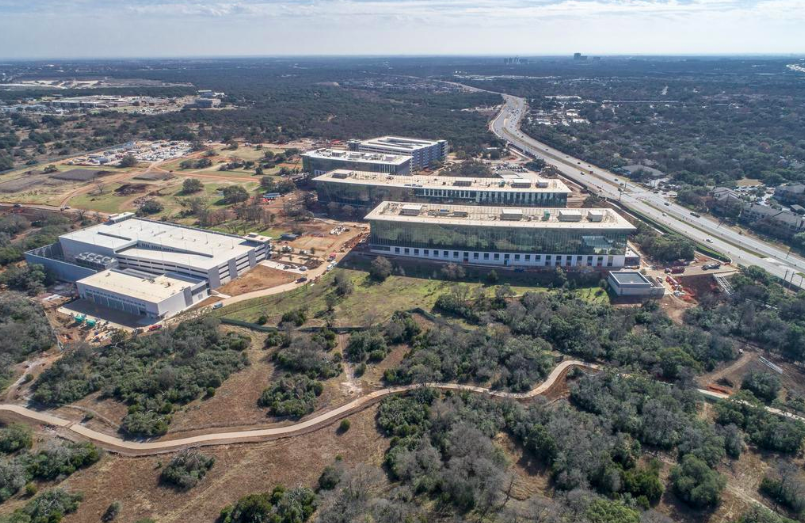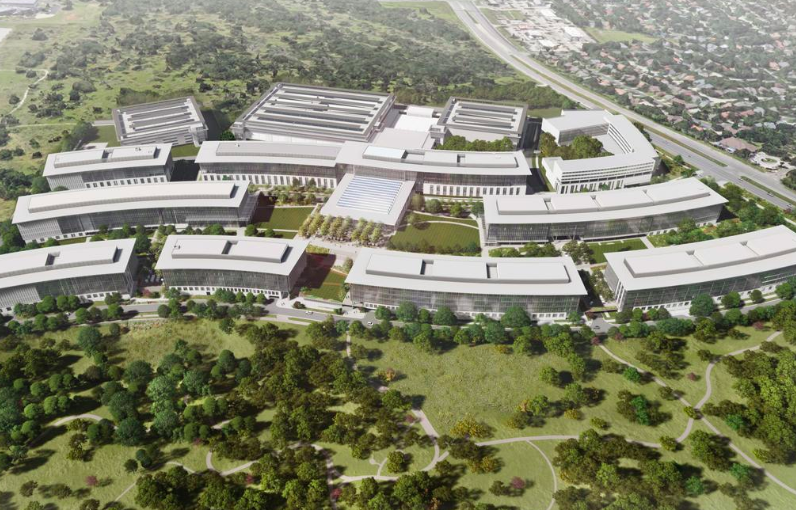Apple Inc. is preparing for the next phase of development at its new campus off West Parmer Lane.
Executives have their eyes on roughly 53 acres of ranch land they’d like to transform. They’re asking Austin City Hall to annex the property so it can be rezoned for a variety of uses.
The campus was announced in December 2018. Apple has laid out plans to develop the land in five phases. At full buildout, it is expected to be 3 million square feet and include 12 office and amenity buildings, parking garages, a central utility plant and a separate daycare building, according to past Austin Business Journal reporting. A 192-room hotel and conference center for use by Apple employees were also proposed, according to an April 2020 site plan.
Apple (Nasdaq: AAPL) already has four large buildings on the site, which are receiving finishing touches from construction crews.
This annexation seems to be the next step in that timeline.

The North Austin campus for years has been planned to initially accommodate 5,000 additional employees, with the capacity to grow to 15,000 — putting it in a position to possibly become one of the region’s top-three largest private-sector employers in the region. H-E-B currently ranks No. 1 on that list, with a little more than 19,000 local workers.

City documents state the site is being annexed for future Apple expansion but exact scope and timeline of those plans remain undetermined, according to the company.
Apple told Austin Business Journal there are no immediate plans to develop the land.
But any indication that Apple is still prepping for more campus development is undoubtedly reassuring for real estate professionals. Questions are swirling about how big tech corporations will use their real estate in the future, as remote work transforms the nature of knowledge economy jobs and recession fears cast a pale over publicly traded companies.
Part of the endeavor includes the extension of a road, said Andrei Lubomudrov, a senior planner with the city of Austin.
City Council is expected to consider the annexation of land at 6204 W. Parmer Lane at a July 28 meeting. The property is currently zoned for agricultural use and will need to be annexed by the city to accommodate Apple’s ultimate expansion. The site — which is part of Robinson Ranch, one of the city’s last big undeveloped bastions — is expected to get planned unit development zoning.
Apple (Nasdaq: AAPL) has had a presence in Central Texas for roughly three decades and now employs about 7,000 in the area. In addition to the North Austin campuses, the iPhone and Mac maker has a large building in Southwest Austin near Loop 360 and Bee Caves Road.
Austin is already the company’s largest office hub outside California. Its almost 20-year-old Americas Operations Center near Parmer Lane at 12545 Riata Vista Circle — a three-minute drive from the new campus — is expected to stay open while Apple fleshes out its new campus about a mile or two away. Executives have previously said shuttle buses will transport employees between the North Austin sites.
The company said employees are expected to move into the new Parmer Lane campus later this year.
The new jobs created at the new campus will consist of a variety of functions including engineering, research and development, operations, finance, sales and customer support.
Construction crews broke ground on the company’s new Austin campus in November 2019 with Kansas City-based JE Dunn Construction Co. as general contractor for the project, according to past ABJ reporting.
Austin-based Generational Commercial Properties is also involved in the project, and GCP President Joe Llamas has previously overseen local development for Apple. Llamas did not return requests for comment.
Other members of Apple’s development team include Studio8 Architects, which designed the campus and its buildings; Nudge Design as landscape architect; Garza EMC as civil engineer; Cardno for structural engineering; and Bay & Associates for mechanical, electrical and plumbing engineering, according to past reporting.
The Article is from Austin Business Journal, copyright belongs to owner

